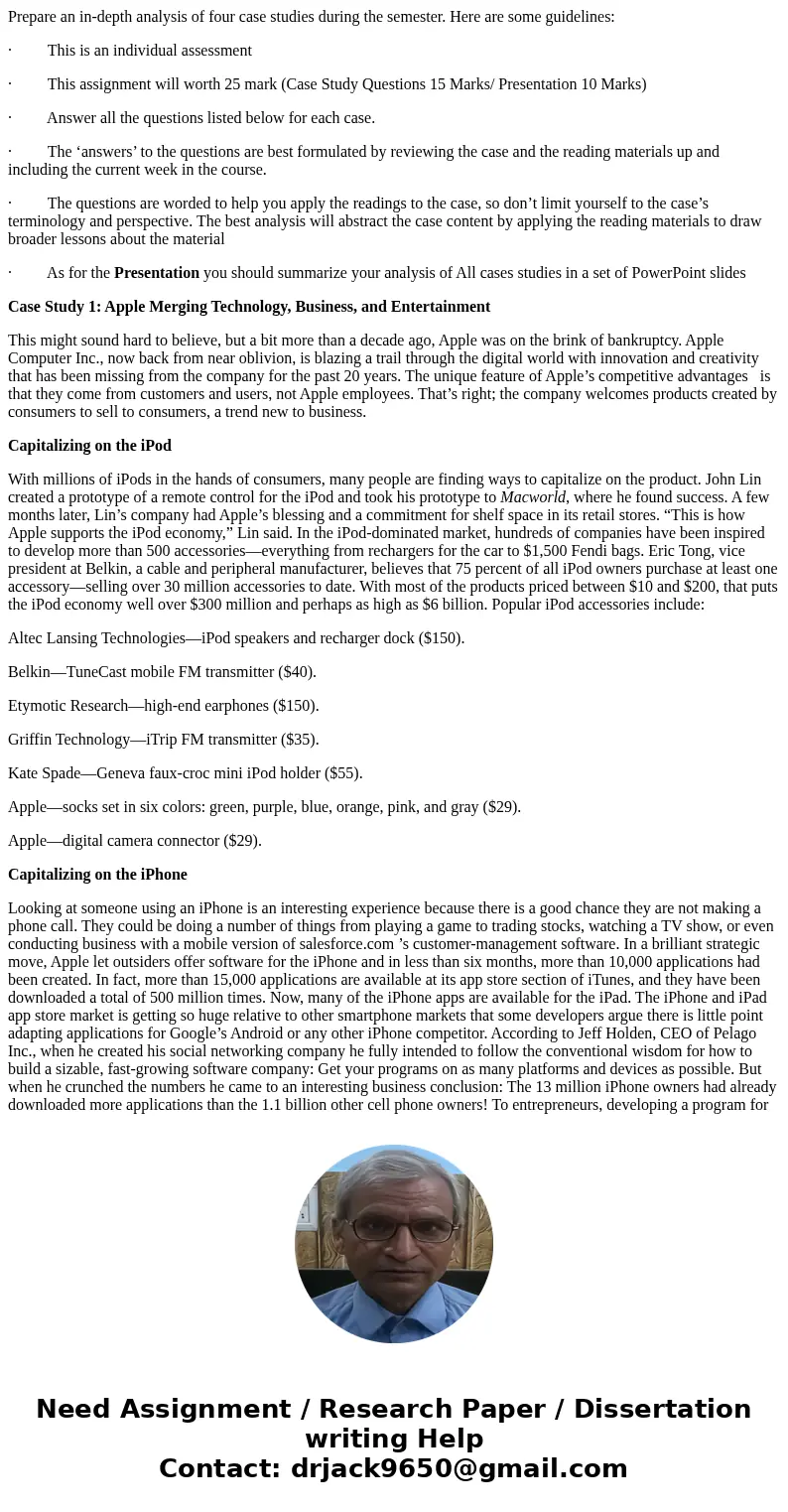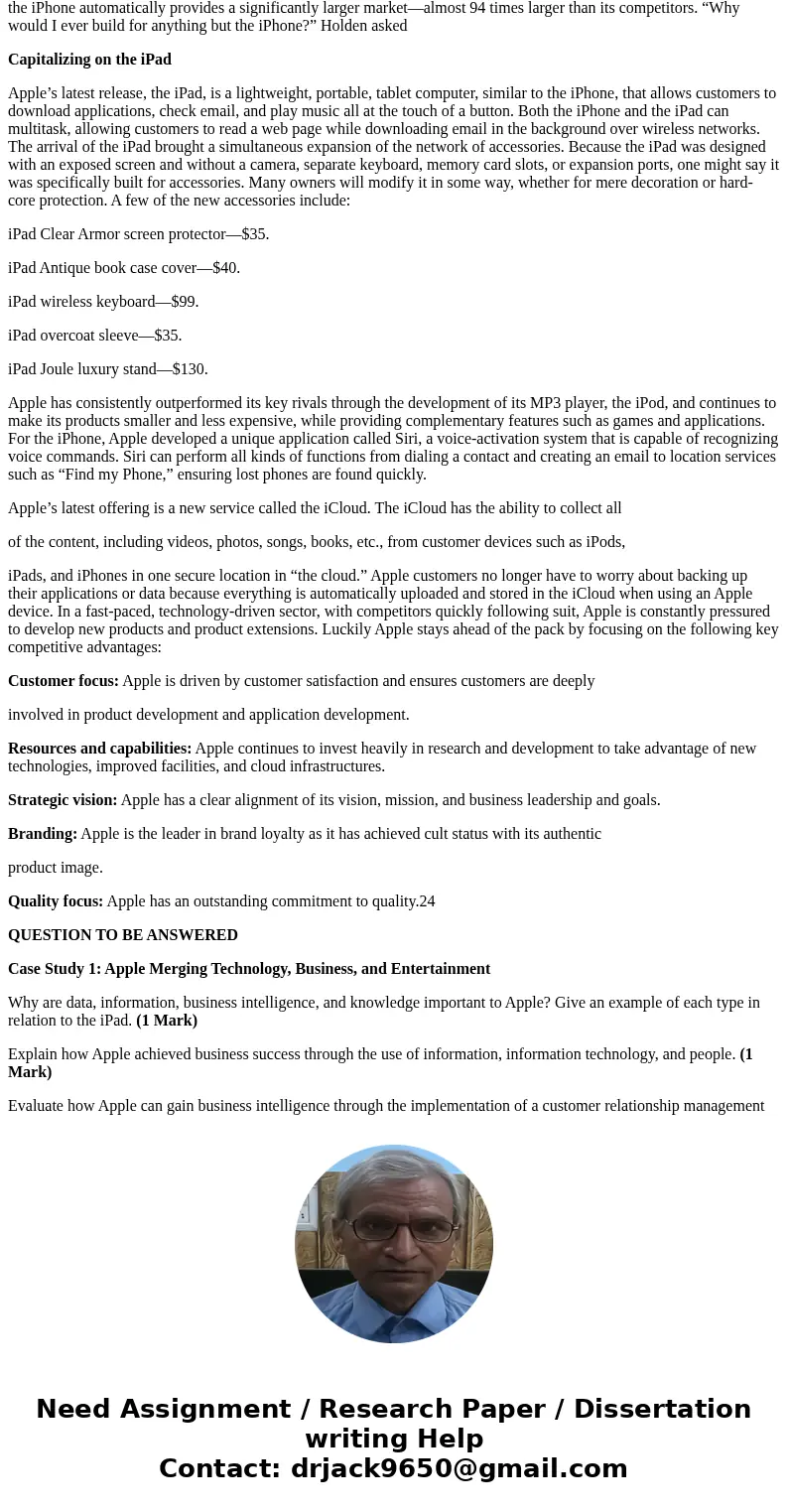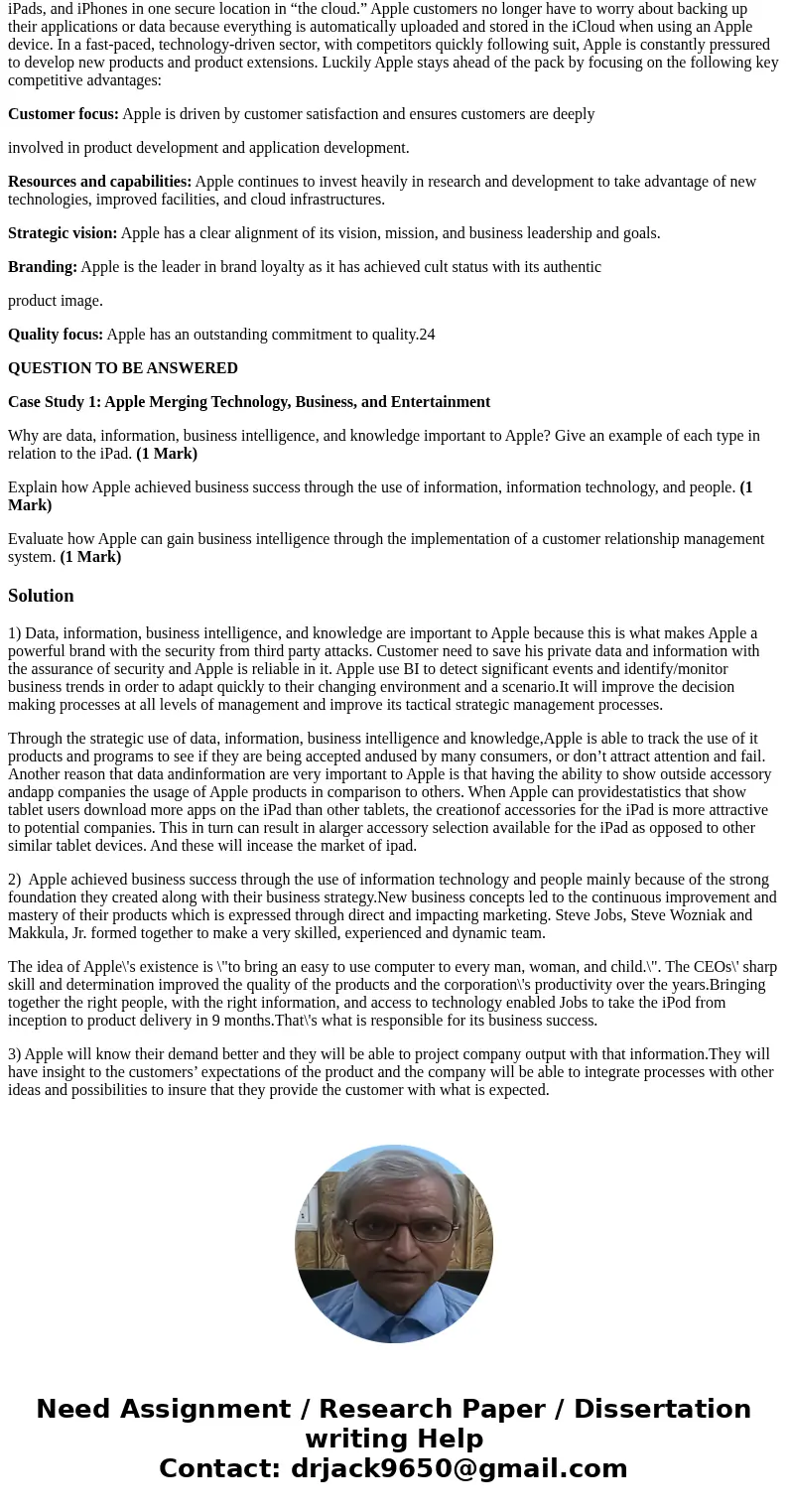Prepare an indepth analysis of four case studies during the
Prepare an in-depth analysis of four case studies during the semester. Here are some guidelines:
· This is an individual assessment
· This assignment will worth 25 mark (Case Study Questions 15 Marks/ Presentation 10 Marks)
· Answer all the questions listed below for each case.
· The ‘answers’ to the questions are best formulated by reviewing the case and the reading materials up and including the current week in the course.
· The questions are worded to help you apply the readings to the case, so don’t limit yourself to the case’s terminology and perspective. The best analysis will abstract the case content by applying the reading materials to draw broader lessons about the material
· As for the Presentation you should summarize your analysis of All cases studies in a set of PowerPoint slides
Case Study 1: Apple Merging Technology, Business, and Entertainment
This might sound hard to believe, but a bit more than a decade ago, Apple was on the brink of bankruptcy. Apple Computer Inc., now back from near oblivion, is blazing a trail through the digital world with innovation and creativity that has been missing from the company for the past 20 years. The unique feature of Apple’s competitive advantages is that they come from customers and users, not Apple employees. That’s right; the company welcomes products created by consumers to sell to consumers, a trend new to business.
Capitalizing on the iPod
With millions of iPods in the hands of consumers, many people are finding ways to capitalize on the product. John Lin created a prototype of a remote control for the iPod and took his prototype to Macworld, where he found success. A few months later, Lin’s company had Apple’s blessing and a commitment for shelf space in its retail stores. “This is how Apple supports the iPod economy,” Lin said. In the iPod-dominated market, hundreds of companies have been inspired to develop more than 500 accessories—everything from rechargers for the car to $1,500 Fendi bags. Eric Tong, vice president at Belkin, a cable and peripheral manufacturer, believes that 75 percent of all iPod owners purchase at least one accessory—selling over 30 million accessories to date. With most of the products priced between $10 and $200, that puts the iPod economy well over $300 million and perhaps as high as $6 billion. Popular iPod accessories include:
Altec Lansing Technologies—iPod speakers and recharger dock ($150).
Belkin—TuneCast mobile FM transmitter ($40).
Etymotic Research—high-end earphones ($150).
Griffin Technology—iTrip FM transmitter ($35).
Kate Spade—Geneva faux-croc mini iPod holder ($55).
Apple—socks set in six colors: green, purple, blue, orange, pink, and gray ($29).
Apple—digital camera connector ($29).
Capitalizing on the iPhone
Looking at someone using an iPhone is an interesting experience because there is a good chance they are not making a phone call. They could be doing a number of things from playing a game to trading stocks, watching a TV show, or even conducting business with a mobile version of salesforce.com ’s customer-management software. In a brilliant strategic move, Apple let outsiders offer software for the iPhone and in less than six months, more than 10,000 applications had been created. In fact, more than 15,000 applications are available at its app store section of iTunes, and they have been downloaded a total of 500 million times. Now, many of the iPhone apps are available for the iPad. The iPhone and iPad app store market is getting so huge relative to other smartphone markets that some developers argue there is little point adapting applications for Google’s Android or any other iPhone competitor. According to Jeff Holden, CEO of Pelago Inc., when he created his social networking company he fully intended to follow the conventional wisdom for how to build a sizable, fast-growing software company: Get your programs on as many platforms and devices as possible. But when he crunched the numbers he came to an interesting business conclusion: The 13 million iPhone owners had already downloaded more applications than the 1.1 billion other cell phone owners! To entrepreneurs, developing a program for the iPhone automatically provides a significantly larger market—almost 94 times larger than its competitors. “Why would I ever build for anything but the iPhone?” Holden asked
Capitalizing on the iPad
Apple’s latest release, the iPad, is a lightweight, portable, tablet computer, similar to the iPhone, that allows customers to download applications, check email, and play music all at the touch of a button. Both the iPhone and the iPad can multitask, allowing customers to read a web page while downloading email in the background over wireless networks. The arrival of the iPad brought a simultaneous expansion of the network of accessories. Because the iPad was designed with an exposed screen and without a camera, separate keyboard, memory card slots, or expansion ports, one might say it was specifically built for accessories. Many owners will modify it in some way, whether for mere decoration or hard-core protection. A few of the new accessories include:
iPad Clear Armor screen protector—$35.
iPad Antique book case cover—$40.
iPad wireless keyboard—$99.
iPad overcoat sleeve—$35.
iPad Joule luxury stand—$130.
Apple has consistently outperformed its key rivals through the development of its MP3 player, the iPod, and continues to make its products smaller and less expensive, while providing complementary features such as games and applications. For the iPhone, Apple developed a unique application called Siri, a voice-activation system that is capable of recognizing voice commands. Siri can perform all kinds of functions from dialing a contact and creating an email to location services such as “Find my Phone,” ensuring lost phones are found quickly.
Apple’s latest offering is a new service called the iCloud. The iCloud has the ability to collect all
of the content, including videos, photos, songs, books, etc., from customer devices such as iPods,
iPads, and iPhones in one secure location in “the cloud.” Apple customers no longer have to worry about backing up their applications or data because everything is automatically uploaded and stored in the iCloud when using an Apple device. In a fast-paced, technology-driven sector, with competitors quickly following suit, Apple is constantly pressured to develop new products and product extensions. Luckily Apple stays ahead of the pack by focusing on the following key competitive advantages:
Customer focus: Apple is driven by customer satisfaction and ensures customers are deeply
involved in product development and application development.
Resources and capabilities: Apple continues to invest heavily in research and development to take advantage of new technologies, improved facilities, and cloud infrastructures.
Strategic vision: Apple has a clear alignment of its vision, mission, and business leadership and goals.
Branding: Apple is the leader in brand loyalty as it has achieved cult status with its authentic
product image.
Quality focus: Apple has an outstanding commitment to quality.24
QUESTION TO BE ANSWERED
Case Study 1: Apple Merging Technology, Business, and Entertainment
Why are data, information, business intelligence, and knowledge important to Apple? Give an example of each type in relation to the iPad. (1 Mark)
Explain how Apple achieved business success through the use of information, information technology, and people. (1 Mark)
Evaluate how Apple can gain business intelligence through the implementation of a customer relationship management system. (1 Mark)
Solution
1) Data, information, business intelligence, and knowledge are important to Apple because this is what makes Apple a powerful brand with the security from third party attacks. Customer need to save his private data and information with the assurance of security and Apple is reliable in it. Apple use BI to detect significant events and identify/monitor business trends in order to adapt quickly to their changing environment and a scenario.It will improve the decision making processes at all levels of management and improve its tactical strategic management processes.
Through the strategic use of data, information, business intelligence and knowledge,Apple is able to track the use of it products and programs to see if they are being accepted andused by many consumers, or don’t attract attention and fail. Another reason that data andinformation are very important to Apple is that having the ability to show outside accessory andapp companies the usage of Apple products in comparison to others. When Apple can providestatistics that show tablet users download more apps on the iPad than other tablets, the creationof accessories for the iPad is more attractive to potential companies. This in turn can result in alarger accessory selection available for the iPad as opposed to other similar tablet devices. And these will incease the market of ipad.
2) Apple achieved business success through the use of information technology and people mainly because of the strong foundation they created along with their business strategy.New business concepts led to the continuous improvement and mastery of their products which is expressed through direct and impacting marketing. Steve Jobs, Steve Wozniak and Makkula, Jr. formed together to make a very skilled, experienced and dynamic team.
The idea of Apple\'s existence is \"to bring an easy to use computer to every man, woman, and child.\". The CEOs\' sharp skill and determination improved the quality of the products and the corporation\'s productivity over the years.Bringing together the right people, with the right information, and access to technology enabled Jobs to take the iPod from inception to product delivery in 9 months.That\'s what is responsible for its business success.
3) Apple will know their demand better and they will be able to project company output with that information.They will have insight to the customers’ expectations of the product and the company will be able to integrate processes with other ideas and possibilities to insure that they provide the customer with what is expected.



 Homework Sourse
Homework Sourse